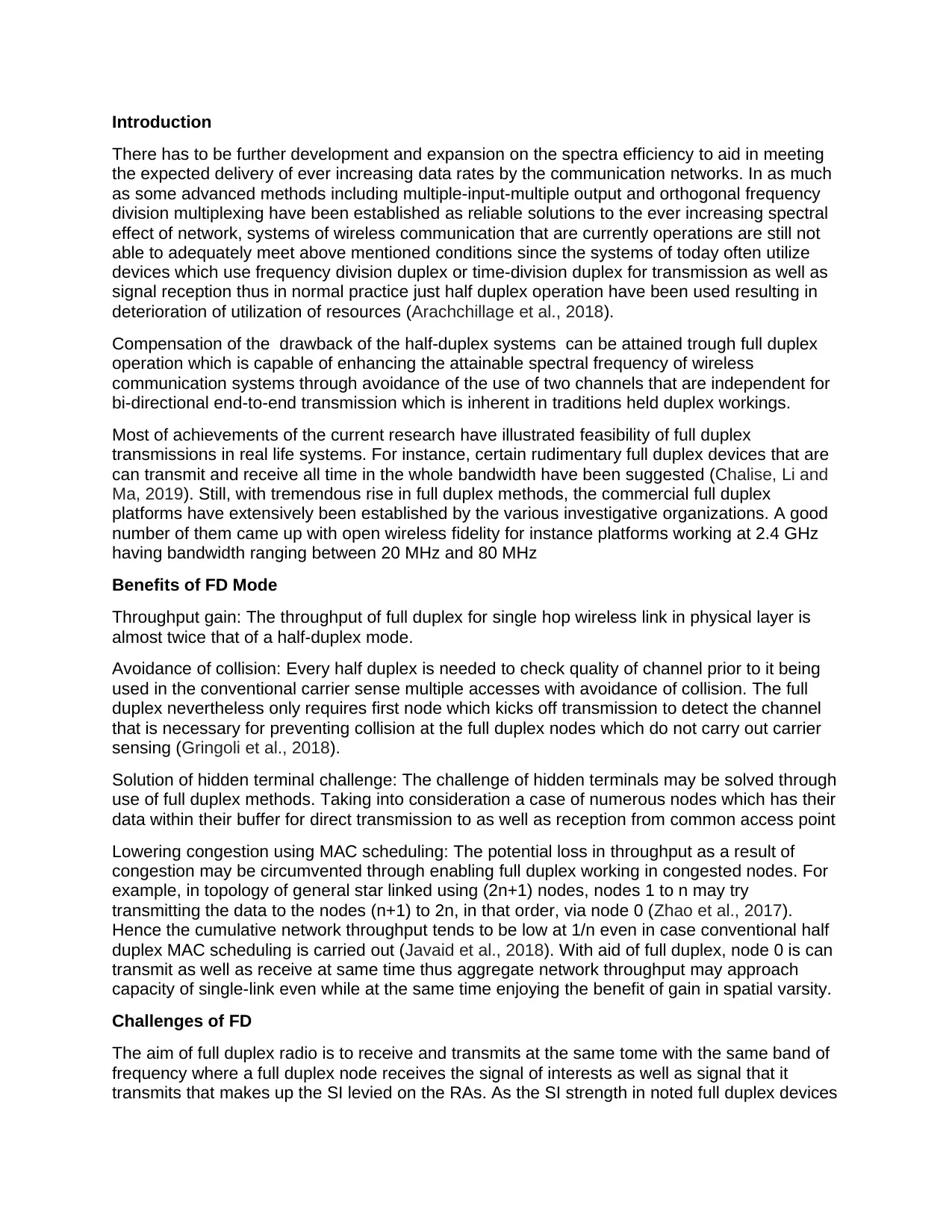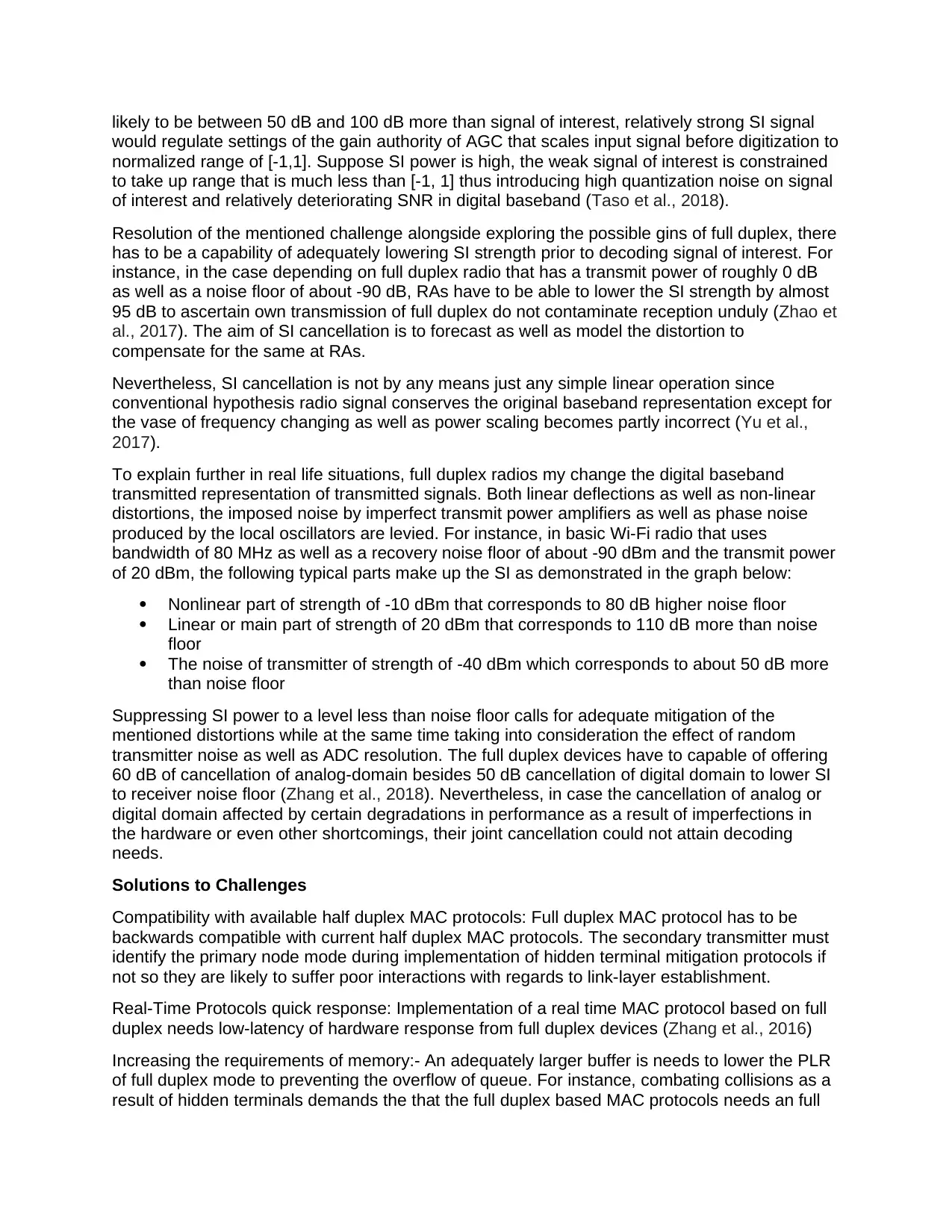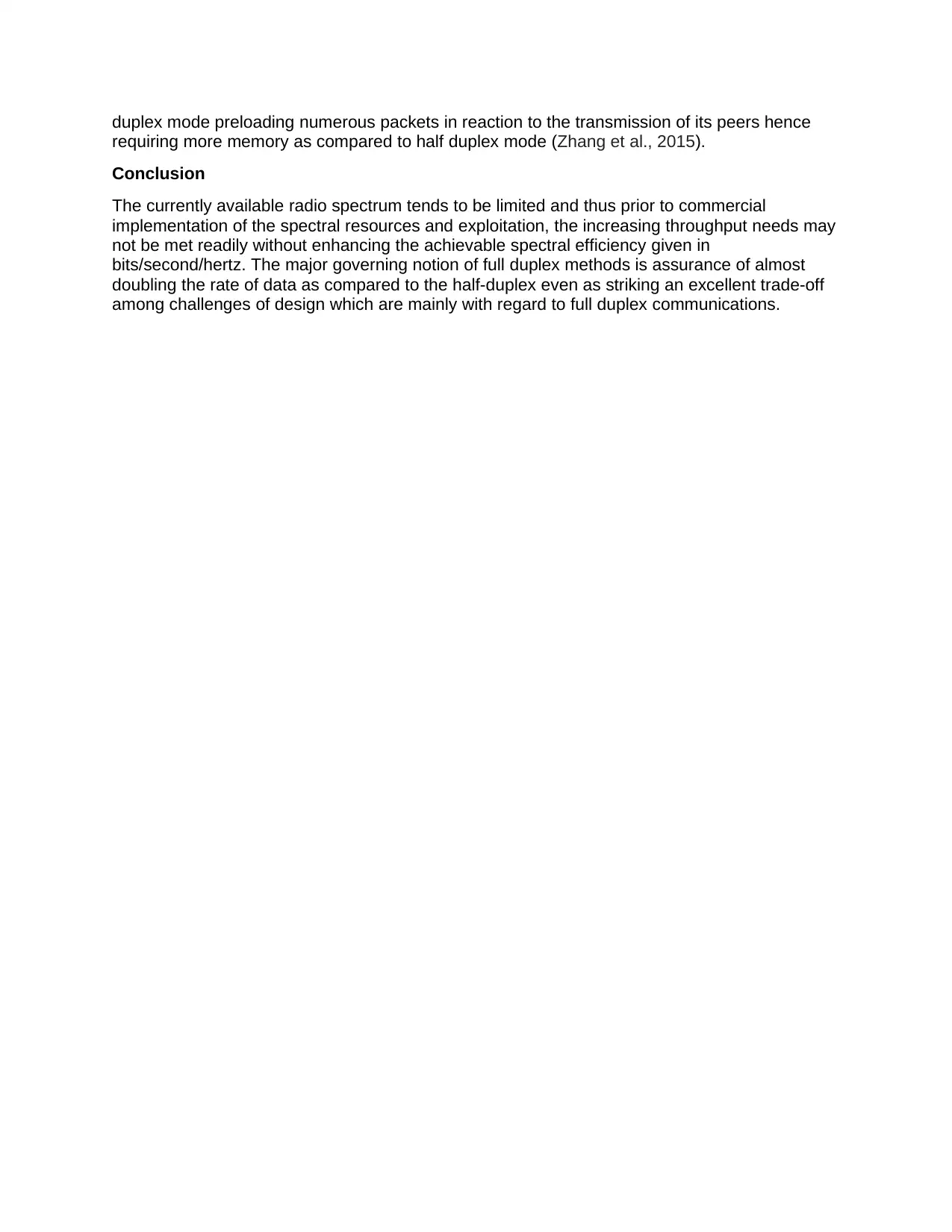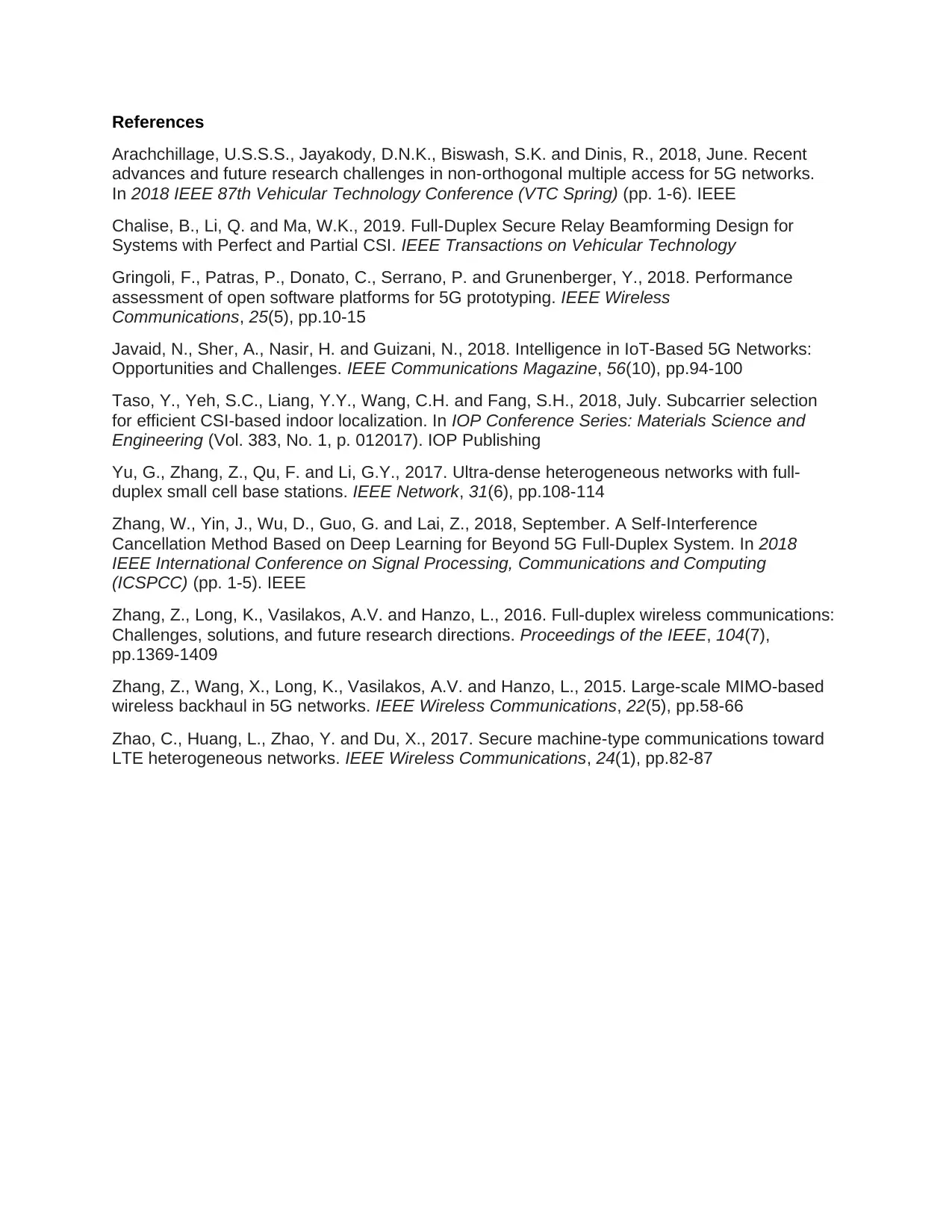Challenges and Solutions in Full Duplex Communication Systems
VerifiedAdded on 2023/03/31
|5
|1610
|201
AI Summary
This article discusses the challenges and solutions in full duplex communication systems. It explores the benefits of full duplex mode, such as increased throughput and avoidance of collisions. The article also highlights the challenges of full duplex, including the need for SI cancellation and compatibility with existing MAC protocols. Overall, full duplex communication systems offer a promising solution for enhancing spectral efficiency and overcoming hidden terminal challenges.
Contribute Materials
Your contribution can guide someone’s learning journey. Share your
documents today.

PERSONAL COMMUNICATION SYSTEMS
By Name
Course
Instructor
Institution
Location
Date
By Name
Course
Instructor
Institution
Location
Date
Secure Best Marks with AI Grader
Need help grading? Try our AI Grader for instant feedback on your assignments.

Introduction
There has to be further development and expansion on the spectra efficiency to aid in meeting
the expected delivery of ever increasing data rates by the communication networks. In as much
as some advanced methods including multiple-input-multiple output and orthogonal frequency
division multiplexing have been established as reliable solutions to the ever increasing spectral
effect of network, systems of wireless communication that are currently operations are still not
able to adequately meet above mentioned conditions since the systems of today often utilize
devices which use frequency division duplex or time-division duplex for transmission as well as
signal reception thus in normal practice just half duplex operation have been used resulting in
deterioration of utilization of resources (Arachchillage et al., 2018).
Compensation of the drawback of the half-duplex systems can be attained trough full duplex
operation which is capable of enhancing the attainable spectral frequency of wireless
communication systems through avoidance of the use of two channels that are independent for
bi-directional end-to-end transmission which is inherent in traditions held duplex workings.
Most of achievements of the current research have illustrated feasibility of full duplex
transmissions in real life systems. For instance, certain rudimentary full duplex devices that are
can transmit and receive all time in the whole bandwidth have been suggested (Chalise, Li and
Ma, 2019). Still, with tremendous rise in full duplex methods, the commercial full duplex
platforms have extensively been established by the various investigative organizations. A good
number of them came up with open wireless fidelity for instance platforms working at 2.4 GHz
having bandwidth ranging between 20 MHz and 80 MHz
Benefits of FD Mode
Throughput gain: The throughput of full duplex for single hop wireless link in physical layer is
almost twice that of a half-duplex mode.
Avoidance of collision: Every half duplex is needed to check quality of channel prior to it being
used in the conventional carrier sense multiple accesses with avoidance of collision. The full
duplex nevertheless only requires first node which kicks off transmission to detect the channel
that is necessary for preventing collision at the full duplex nodes which do not carry out carrier
sensing (Gringoli et al., 2018).
Solution of hidden terminal challenge: The challenge of hidden terminals may be solved through
use of full duplex methods. Taking into consideration a case of numerous nodes which has their
data within their buffer for direct transmission to as well as reception from common access point
Lowering congestion using MAC scheduling: The potential loss in throughput as a result of
congestion may be circumvented through enabling full duplex working in congested nodes. For
example, in topology of general star linked using (2n+1) nodes, nodes 1 to n may try
transmitting the data to the nodes (n+1) to 2n, in that order, via node 0 (Zhao et al., 2017).
Hence the cumulative network throughput tends to be low at 1/n even in case conventional half
duplex MAC scheduling is carried out (Javaid et al., 2018). With aid of full duplex, node 0 is can
transmit as well as receive at same time thus aggregate network throughput may approach
capacity of single-link even while at the same time enjoying the benefit of gain in spatial varsity.
Challenges of FD
The aim of full duplex radio is to receive and transmits at the same tome with the same band of
frequency where a full duplex node receives the signal of interests as well as signal that it
transmits that makes up the SI levied on the RAs. As the SI strength in noted full duplex devices
There has to be further development and expansion on the spectra efficiency to aid in meeting
the expected delivery of ever increasing data rates by the communication networks. In as much
as some advanced methods including multiple-input-multiple output and orthogonal frequency
division multiplexing have been established as reliable solutions to the ever increasing spectral
effect of network, systems of wireless communication that are currently operations are still not
able to adequately meet above mentioned conditions since the systems of today often utilize
devices which use frequency division duplex or time-division duplex for transmission as well as
signal reception thus in normal practice just half duplex operation have been used resulting in
deterioration of utilization of resources (Arachchillage et al., 2018).
Compensation of the drawback of the half-duplex systems can be attained trough full duplex
operation which is capable of enhancing the attainable spectral frequency of wireless
communication systems through avoidance of the use of two channels that are independent for
bi-directional end-to-end transmission which is inherent in traditions held duplex workings.
Most of achievements of the current research have illustrated feasibility of full duplex
transmissions in real life systems. For instance, certain rudimentary full duplex devices that are
can transmit and receive all time in the whole bandwidth have been suggested (Chalise, Li and
Ma, 2019). Still, with tremendous rise in full duplex methods, the commercial full duplex
platforms have extensively been established by the various investigative organizations. A good
number of them came up with open wireless fidelity for instance platforms working at 2.4 GHz
having bandwidth ranging between 20 MHz and 80 MHz
Benefits of FD Mode
Throughput gain: The throughput of full duplex for single hop wireless link in physical layer is
almost twice that of a half-duplex mode.
Avoidance of collision: Every half duplex is needed to check quality of channel prior to it being
used in the conventional carrier sense multiple accesses with avoidance of collision. The full
duplex nevertheless only requires first node which kicks off transmission to detect the channel
that is necessary for preventing collision at the full duplex nodes which do not carry out carrier
sensing (Gringoli et al., 2018).
Solution of hidden terminal challenge: The challenge of hidden terminals may be solved through
use of full duplex methods. Taking into consideration a case of numerous nodes which has their
data within their buffer for direct transmission to as well as reception from common access point
Lowering congestion using MAC scheduling: The potential loss in throughput as a result of
congestion may be circumvented through enabling full duplex working in congested nodes. For
example, in topology of general star linked using (2n+1) nodes, nodes 1 to n may try
transmitting the data to the nodes (n+1) to 2n, in that order, via node 0 (Zhao et al., 2017).
Hence the cumulative network throughput tends to be low at 1/n even in case conventional half
duplex MAC scheduling is carried out (Javaid et al., 2018). With aid of full duplex, node 0 is can
transmit as well as receive at same time thus aggregate network throughput may approach
capacity of single-link even while at the same time enjoying the benefit of gain in spatial varsity.
Challenges of FD
The aim of full duplex radio is to receive and transmits at the same tome with the same band of
frequency where a full duplex node receives the signal of interests as well as signal that it
transmits that makes up the SI levied on the RAs. As the SI strength in noted full duplex devices

likely to be between 50 dB and 100 dB more than signal of interest, relatively strong SI signal
would regulate settings of the gain authority of AGC that scales input signal before digitization to
normalized range of [-1,1]. Suppose SI power is high, the weak signal of interest is constrained
to take up range that is much less than [-1, 1] thus introducing high quantization noise on signal
of interest and relatively deteriorating SNR in digital baseband (Taso et al., 2018).
Resolution of the mentioned challenge alongside exploring the possible gins of full duplex, there
has to be a capability of adequately lowering SI strength prior to decoding signal of interest. For
instance, in the case depending on full duplex radio that has a transmit power of roughly 0 dB
as well as a noise floor of about -90 dB, RAs have to be able to lower the SI strength by almost
95 dB to ascertain own transmission of full duplex do not contaminate reception unduly (Zhao et
al., 2017). The aim of SI cancellation is to forecast as well as model the distortion to
compensate for the same at RAs.
Nevertheless, SI cancellation is not by any means just any simple linear operation since
conventional hypothesis radio signal conserves the original baseband representation except for
the vase of frequency changing as well as power scaling becomes partly incorrect (Yu et al.,
2017).
To explain further in real life situations, full duplex radios my change the digital baseband
transmitted representation of transmitted signals. Both linear deflections as well as non-linear
distortions, the imposed noise by imperfect transmit power amplifiers as well as phase noise
produced by the local oscillators are levied. For instance, in basic Wi-Fi radio that uses
bandwidth of 80 MHz as well as a recovery noise floor of about -90 dBm and the transmit power
of 20 dBm, the following typical parts make up the SI as demonstrated in the graph below:
Nonlinear part of strength of -10 dBm that corresponds to 80 dB higher noise floor
Linear or main part of strength of 20 dBm that corresponds to 110 dB more than noise
floor
The noise of transmitter of strength of -40 dBm which corresponds to about 50 dB more
than noise floor
Suppressing SI power to a level less than noise floor calls for adequate mitigation of the
mentioned distortions while at the same time taking into consideration the effect of random
transmitter noise as well as ADC resolution. The full duplex devices have to capable of offering
60 dB of cancellation of analog-domain besides 50 dB cancellation of digital domain to lower SI
to receiver noise floor (Zhang et al., 2018). Nevertheless, in case the cancellation of analog or
digital domain affected by certain degradations in performance as a result of imperfections in
the hardware or even other shortcomings, their joint cancellation could not attain decoding
needs.
Solutions to Challenges
Compatibility with available half duplex MAC protocols: Full duplex MAC protocol has to be
backwards compatible with current half duplex MAC protocols. The secondary transmitter must
identify the primary node mode during implementation of hidden terminal mitigation protocols if
not so they are likely to suffer poor interactions with regards to link-layer establishment.
Real-Time Protocols quick response: Implementation of a real time MAC protocol based on full
duplex needs low-latency of hardware response from full duplex devices (Zhang et al., 2016)
Increasing the requirements of memory:- An adequately larger buffer is needs to lower the PLR
of full duplex mode to preventing the overflow of queue. For instance, combating collisions as a
result of hidden terminals demands the that the full duplex based MAC protocols needs an full
would regulate settings of the gain authority of AGC that scales input signal before digitization to
normalized range of [-1,1]. Suppose SI power is high, the weak signal of interest is constrained
to take up range that is much less than [-1, 1] thus introducing high quantization noise on signal
of interest and relatively deteriorating SNR in digital baseband (Taso et al., 2018).
Resolution of the mentioned challenge alongside exploring the possible gins of full duplex, there
has to be a capability of adequately lowering SI strength prior to decoding signal of interest. For
instance, in the case depending on full duplex radio that has a transmit power of roughly 0 dB
as well as a noise floor of about -90 dB, RAs have to be able to lower the SI strength by almost
95 dB to ascertain own transmission of full duplex do not contaminate reception unduly (Zhao et
al., 2017). The aim of SI cancellation is to forecast as well as model the distortion to
compensate for the same at RAs.
Nevertheless, SI cancellation is not by any means just any simple linear operation since
conventional hypothesis radio signal conserves the original baseband representation except for
the vase of frequency changing as well as power scaling becomes partly incorrect (Yu et al.,
2017).
To explain further in real life situations, full duplex radios my change the digital baseband
transmitted representation of transmitted signals. Both linear deflections as well as non-linear
distortions, the imposed noise by imperfect transmit power amplifiers as well as phase noise
produced by the local oscillators are levied. For instance, in basic Wi-Fi radio that uses
bandwidth of 80 MHz as well as a recovery noise floor of about -90 dBm and the transmit power
of 20 dBm, the following typical parts make up the SI as demonstrated in the graph below:
Nonlinear part of strength of -10 dBm that corresponds to 80 dB higher noise floor
Linear or main part of strength of 20 dBm that corresponds to 110 dB more than noise
floor
The noise of transmitter of strength of -40 dBm which corresponds to about 50 dB more
than noise floor
Suppressing SI power to a level less than noise floor calls for adequate mitigation of the
mentioned distortions while at the same time taking into consideration the effect of random
transmitter noise as well as ADC resolution. The full duplex devices have to capable of offering
60 dB of cancellation of analog-domain besides 50 dB cancellation of digital domain to lower SI
to receiver noise floor (Zhang et al., 2018). Nevertheless, in case the cancellation of analog or
digital domain affected by certain degradations in performance as a result of imperfections in
the hardware or even other shortcomings, their joint cancellation could not attain decoding
needs.
Solutions to Challenges
Compatibility with available half duplex MAC protocols: Full duplex MAC protocol has to be
backwards compatible with current half duplex MAC protocols. The secondary transmitter must
identify the primary node mode during implementation of hidden terminal mitigation protocols if
not so they are likely to suffer poor interactions with regards to link-layer establishment.
Real-Time Protocols quick response: Implementation of a real time MAC protocol based on full
duplex needs low-latency of hardware response from full duplex devices (Zhang et al., 2016)
Increasing the requirements of memory:- An adequately larger buffer is needs to lower the PLR
of full duplex mode to preventing the overflow of queue. For instance, combating collisions as a
result of hidden terminals demands the that the full duplex based MAC protocols needs an full

duplex mode preloading numerous packets in reaction to the transmission of its peers hence
requiring more memory as compared to half duplex mode (Zhang et al., 2015).
Conclusion
The currently available radio spectrum tends to be limited and thus prior to commercial
implementation of the spectral resources and exploitation, the increasing throughput needs may
not be met readily without enhancing the achievable spectral efficiency given in
bits/second/hertz. The major governing notion of full duplex methods is assurance of almost
doubling the rate of data as compared to the half-duplex even as striking an excellent trade-off
among challenges of design which are mainly with regard to full duplex communications.
requiring more memory as compared to half duplex mode (Zhang et al., 2015).
Conclusion
The currently available radio spectrum tends to be limited and thus prior to commercial
implementation of the spectral resources and exploitation, the increasing throughput needs may
not be met readily without enhancing the achievable spectral efficiency given in
bits/second/hertz. The major governing notion of full duplex methods is assurance of almost
doubling the rate of data as compared to the half-duplex even as striking an excellent trade-off
among challenges of design which are mainly with regard to full duplex communications.
Secure Best Marks with AI Grader
Need help grading? Try our AI Grader for instant feedback on your assignments.

References
Arachchillage, U.S.S.S., Jayakody, D.N.K., Biswash, S.K. and Dinis, R., 2018, June. Recent
advances and future research challenges in non-orthogonal multiple access for 5G networks.
In 2018 IEEE 87th Vehicular Technology Conference (VTC Spring) (pp. 1-6). IEEE
Chalise, B., Li, Q. and Ma, W.K., 2019. Full-Duplex Secure Relay Beamforming Design for
Systems with Perfect and Partial CSI. IEEE Transactions on Vehicular Technology
Gringoli, F., Patras, P., Donato, C., Serrano, P. and Grunenberger, Y., 2018. Performance
assessment of open software platforms for 5G prototyping. IEEE Wireless
Communications, 25(5), pp.10-15
Javaid, N., Sher, A., Nasir, H. and Guizani, N., 2018. Intelligence in IoT-Based 5G Networks:
Opportunities and Challenges. IEEE Communications Magazine, 56(10), pp.94-100
Taso, Y., Yeh, S.C., Liang, Y.Y., Wang, C.H. and Fang, S.H., 2018, July. Subcarrier selection
for efficient CSI-based indoor localization. In IOP Conference Series: Materials Science and
Engineering (Vol. 383, No. 1, p. 012017). IOP Publishing
Yu, G., Zhang, Z., Qu, F. and Li, G.Y., 2017. Ultra-dense heterogeneous networks with full-
duplex small cell base stations. IEEE Network, 31(6), pp.108-114
Zhang, W., Yin, J., Wu, D., Guo, G. and Lai, Z., 2018, September. A Self-Interference
Cancellation Method Based on Deep Learning for Beyond 5G Full-Duplex System. In 2018
IEEE International Conference on Signal Processing, Communications and Computing
(ICSPCC) (pp. 1-5). IEEE
Zhang, Z., Long, K., Vasilakos, A.V. and Hanzo, L., 2016. Full-duplex wireless communications:
Challenges, solutions, and future research directions. Proceedings of the IEEE, 104(7),
pp.1369-1409
Zhang, Z., Wang, X., Long, K., Vasilakos, A.V. and Hanzo, L., 2015. Large-scale MIMO-based
wireless backhaul in 5G networks. IEEE Wireless Communications, 22(5), pp.58-66
Zhao, C., Huang, L., Zhao, Y. and Du, X., 2017. Secure machine-type communications toward
LTE heterogeneous networks. IEEE Wireless Communications, 24(1), pp.82-87
Arachchillage, U.S.S.S., Jayakody, D.N.K., Biswash, S.K. and Dinis, R., 2018, June. Recent
advances and future research challenges in non-orthogonal multiple access for 5G networks.
In 2018 IEEE 87th Vehicular Technology Conference (VTC Spring) (pp. 1-6). IEEE
Chalise, B., Li, Q. and Ma, W.K., 2019. Full-Duplex Secure Relay Beamforming Design for
Systems with Perfect and Partial CSI. IEEE Transactions on Vehicular Technology
Gringoli, F., Patras, P., Donato, C., Serrano, P. and Grunenberger, Y., 2018. Performance
assessment of open software platforms for 5G prototyping. IEEE Wireless
Communications, 25(5), pp.10-15
Javaid, N., Sher, A., Nasir, H. and Guizani, N., 2018. Intelligence in IoT-Based 5G Networks:
Opportunities and Challenges. IEEE Communications Magazine, 56(10), pp.94-100
Taso, Y., Yeh, S.C., Liang, Y.Y., Wang, C.H. and Fang, S.H., 2018, July. Subcarrier selection
for efficient CSI-based indoor localization. In IOP Conference Series: Materials Science and
Engineering (Vol. 383, No. 1, p. 012017). IOP Publishing
Yu, G., Zhang, Z., Qu, F. and Li, G.Y., 2017. Ultra-dense heterogeneous networks with full-
duplex small cell base stations. IEEE Network, 31(6), pp.108-114
Zhang, W., Yin, J., Wu, D., Guo, G. and Lai, Z., 2018, September. A Self-Interference
Cancellation Method Based on Deep Learning for Beyond 5G Full-Duplex System. In 2018
IEEE International Conference on Signal Processing, Communications and Computing
(ICSPCC) (pp. 1-5). IEEE
Zhang, Z., Long, K., Vasilakos, A.V. and Hanzo, L., 2016. Full-duplex wireless communications:
Challenges, solutions, and future research directions. Proceedings of the IEEE, 104(7),
pp.1369-1409
Zhang, Z., Wang, X., Long, K., Vasilakos, A.V. and Hanzo, L., 2015. Large-scale MIMO-based
wireless backhaul in 5G networks. IEEE Wireless Communications, 22(5), pp.58-66
Zhao, C., Huang, L., Zhao, Y. and Du, X., 2017. Secure machine-type communications toward
LTE heterogeneous networks. IEEE Wireless Communications, 24(1), pp.82-87
1 out of 5
Related Documents
Your All-in-One AI-Powered Toolkit for Academic Success.
+13062052269
info@desklib.com
Available 24*7 on WhatsApp / Email
![[object Object]](/_next/static/media/star-bottom.7253800d.svg)
Unlock your academic potential
© 2024 | Zucol Services PVT LTD | All rights reserved.





